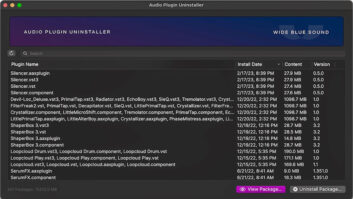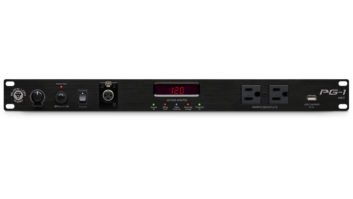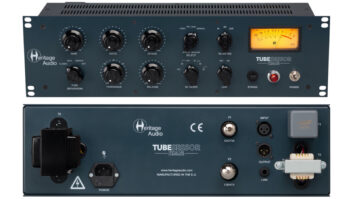
Leave it to the Kiwis to come up with a more reliable andclean-sounding version of the tried-and-true opto-compressor. Retailingat $2,200, the SOC 1.1 from New Zealand’s Buzz Audio is a stereoopto-compressor that expands on this familiar and popular dynamiccontroller’s style and sound.
The SOC is housed in a two-rackspace black cabinet with large,easy-to-grab control knobs. Two large Sifam VU meters are backlit by arow of yellow LEDs highlighting the arc of the VU scale. A look insidereveals good construction with many field-replaceable circuit boardsinterconnected with ribbon cables or hand-wired looms. All of the opamps and line drivers in the signal path are DC-coupled Analog DevicesOP275 chips with high-quality coupling capacitors. The opto gain-changeelement is Buzz Audio’s and uses a Hewlett Packard Quad LED light blockand four specially selected, light-dependent resistor elements.
ON THE FRONT PANEL
The SOC’s front panel has identical controls for channels A and B.When compressing a stereo pair, you’ll have to separately adjust bothchannels and then engage the Separate/Link A/B switch. I found bothchannels to match exactly: You can set the knobs the same and get equalresults, a sign of careful design and quality components. When the twochannels are linked together, audio sent to the sidechains is acomposite of the A/B channel signal, but not a L+R sum. Assuming equalsettings on both channels, with 6 dB of gain reduction on channel A,channel B will reduce 3 dB with no input signal present.
The Drive (threshold) control sets the amount of gain reduction. TheOutput level control goes up to +15 dB of makeup gain. There is no wayto lower the output level when driving -10dBV semi-pro inputs.
Ratio allows users to select from 2:1/5:1/10:1/20:1 settings. Themanual points out that the SOC is a soft-knee compressor, where theselected ratios of either 2:1 or 5:1 are reached only after 10 dB ofgain reduction. The higher ratio settings are achieved sooner, withslightly less than 10 dB for 10:1 and 5 dB for 20:1.
The Release knob is labeled 1, 2, 4, 8 and 16 for 100, 200, 400, 800and 1,600 ms, respectively. Release time is defined as the time ittakes the compressor to recover or return to 0 dB of gain reductionfrom an initial reduction of 20 dB. In Auto mode, the SOC releases fromfast transients quickly, but also releases more slowly for sustain orcontinuous signals such as entire mixes or sustaining sounds.Auto-Release is still fairly fast, and I noticed that switching to thismode lowers the amount of indicated gain reduction as measured by theVU meter.
The Attack switch is a simple, 3-position toggle for Slow at 70 ms,Fast at 1 ms and Auto for program-dependent attack timing. You couldthink of Auto as a medium-fast position; the manual calls this theClassic Sound setting when used with low ratios. The two 3-positionmeter toggle switches change the meters to input, output and gainreduction. The hard-wired bypass design bypasses audio only around thecompressor section, leaving it to continue operating with all controlsand metering active. Live sound mixers will like this feature as theycan “fly by instruments” beforehand and then engage thecompressor between songs.
AT THE SESSION
I used the SOC for typical compression chores and then compared itto other compressors in my rack. Both Auto Attack and Release modes arewell-designed, getting solid results on drum overheads and room mics atmoderate gain reductions. Auto was useful, unlike other compressorswhere I’m not exactly sure what is going on in Automatic mode.
With an Avalon AD2044 set approximately the same, the SOC was moreforward-sounding with not as much top and bottom. My best vintage1176LN Rev D sounded thin and boxy, and a Summit TLA-100 sounded tubeyand round, but duller and with less accuracy and positive dynamicscontrol than the SOC. An old dbx 160 exhibited a transistorized,“in your face” quality, but was much thinner andsmaller-sounding than either the SOC or the other compressors.
On snare drum tracks and overheads, the SOC was the best in therack. Even if you like an extreme clamp on drum tracks, the SOC does itcleanly with less distortion and compressor artifacts. I found itwarmer than the 1176LN and, although the Summit seemed to make thesnare track sound more present, the SOC didn’t dull as much.
Acoustic guitars, electric bass and upright bass sounded modernthrough the SOC. Compared to the Avalon, I found it just as clean andnoise-free, with upright bass sounding better in the SOC because Icould set a longer release time. The 1176LN and dbx were not great onthese instruments. The Summit sounded good, but it didn’t offer tightenough control (with its fixed ratio) at only 3 to 5 dB of gainreduction.
Vocal recording and optos have a long history together, and strictdynamic control of a rangy vocalist usually required big squashes, withthe vocal sometimes sounding more like the compressor than the singer.With the SOC, you get the whole vibe, sound and action of a good optobut with faster attack times for less overshoot of occasional vocalpeaks. The SOC changed the singer’s sound very little, even under gainreductions of up to 10 dB (VU) during big chorus sections. I usedeither 2:1 or 5:1 ratios, Fast or Auto attack, 400- or 800ms releasetime and about 2 to 7 dB (VU) of compression.
With more control, and quieter and cleaner sound even at extremesettings, the SOC 1.1 is a fine choice for a neutral-sounding,general-purpose compressor. I liked its simple and accurate operation,reliable performance and modern sound.
Buzz Audio, 64/4/385-2478, www.buzzaudio.com.







